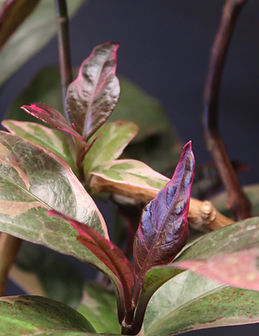
You've got plants.
But do you have
a Big Guy?
_JPG.jpg)
_JPG.jpg)

_JPG.jpg)
Purple False Eranthemum
PSEUDERANTHEMUM atropurpureum "Tricolor"
(soo-der-AN-theh-mum at-roh-per-PER-ee-um TRYE-kol-or)
_JPG.jpg)
_JPG.jpg)
_JPG.jpg)
_JPG.jpg)
About Big Guy
_JPG.jpg)


Who is Big Guy? Let's start the story:
It was the year 2000 and I (Lacey) had just met the love of my life (Eric). He gifted me a little plant; a small cutting 3 inches tall with 4 leaves. I immediatly fell in love with it and asked what it was. He shrugged, he didn't know. So we nicknamed the plant "Big Guy", and encouraged him to grow big and strong.
It took me time to figure out what this plant liked: from soil conditions to watering schedule and fertilizing and light. Meanwhile, I was always looking for another plant that looked like mine. It couldn't be that rare, could it?
I discovered the name of this plant one day when out thrifting. I found a card catalog with popular plants from the 1970's. And there, was my plant: A False Purple Eranthemum.
This plant grows as an upright shrub and can reach heights of 15 ft. My #1 Big Guy is approaching 6ft tall. It is a tropical plant believed to be a native of South Pacific Islands.
I learned about Bonsai, and wanted to create something new and different combined with tried and true techniques.
Each Big Guy is taken as a cutting and designated by who they come from (#1-6 excluding #4 which didn't make it) and then a letter. They earn their letter when they go from the nursery to their first 3" pot. Some plants haven't made it, and I retire those letters from use. Plants have the same general leaf shape with variations of color going from deep purple, pinks, creams, and fade to greens and yellows. Each plant has a unique Nebari. Some plants I see the shape they are going to take right from the start. Others vex me in what form they are supposed to take, and I love that too.
I look forward to sharing my Big Guys with the world. I want to make more, but I have no more space for plants. So it's time for these Big Guys to find new friends. And when you meet him, please be nice and say:
"Well Hello Big Guy. My goodness you're looking beautiful today."
_JPG.jpg)
Living Sculptures
Shaped by Time
Care Guide
Light: Medium to High light (near bright east or south window)
*Currently grows under Monios-L Led Grow Lights for Indoor Plants Full Spectrum,T8 2FT 144W - 3 on each level
Water Keep the potting mixture moist, but plant can tolerate some drying. Limp leaves can indicate an immediate need for water.
Humidity: Average (25% or more)
Fertilization: Apply fertilizer as indicated by the manfucturer. This plant loves a regular feeding schedule. I use both granular and liquid, and the plants seem to prefer the liquid one more.
Propogation: Tip cuttings of 2 to 4 inches with 4 or more leaves.
Potting Mix: Chunky soil mix with addition of perlite and bark to create air pockets in the soil. Repot every 1-2 years when young. Repot every 5-10 years with mature plant. A heavy pot is highly recommended as the plant tends to become top-heavy.
Care tips: The plant will become leggy over time as it reaches for the light. Regular pruning will promote branching and a healthy, thick trunk.
Insects: will love this plant as much as you do. Fungus gnats can become an issue, as this plant prefers to have moist soil. Thrips and spider mites love the nooks and crannies. Be on the lookout for scale, and at the first sign of honey dew on leaves get out your magnifying glass and find them. They should be removed with a q-tip dipped in alcohol. Check the entire plant for hidden ones. Regular application of a systemic houseplant insect control is strongly advised. Regular showers help to keep bugs from making homes along with washing dust off. When needed, I highly reccommend spraying with the insecticide Atticus Spliven, making the mixture fresh every time, and completely soaking the plants. This, along with the granular systemic, keeps most pests away.



